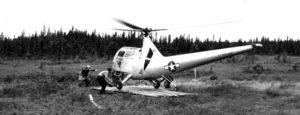The Gander Rescue
Perhaps the most significant helicopter rescue of the immediate post-war period. — Robert Beggs, AHMEC Co-Founder

On September 18, 1946, a Sabena Airlines DC-4 airliner crashed in bad weather 20 miles southeast of Newfoundland’s Gander Airport. The DC-4 had departed Shannon, Ireland, with 37 passengers and 7 crew. A TWA captain spotted the crash site from the air the following day.
Two Coast Guard helicopters were dismantled for shipping and flown on military cargo aircraft to Gander: an HNS-1 (R-4) from Elizabeth City, NC, and an HOS-1 (R-6) from Brooklyn, NY.
While the helicopters were being reassembled, a lumber pad was laid in a marshy clearing close to the crash site in the woods. A second lakeside landing pad seven miles away allowed Coast Guard PBY amphibious aircraft to carry survivors onward to Gander.
The HOS-1 moved eight seriously injured stretcher cases before dark on its first day of operations. The next day, two helicopters evacuated the remaining survivors, plus a 14-member U.S. Army team and several other rescuers. The helicopters then ferried investigators and airline officials to and from the crash site.
The two helicopters made 40 flights into the clearing and rescued 18 surviving passengers and crew. The helicopter and PBY pilots and support crew were awarded Air Medals and Belgium’s “Knight of the Order of Leopold” Medals.
This major rescue was headline news in Europe and the U.S. It was featured on newsreels, in Time Magazine, and in the Illustrated London News. It established in the public’s mind the role of helicopters as rescue aircraft and secured a place in the Coast Guard inventory for helicopters.
The HOS-1 was later named Gander Express and is restored to a place of honor in the American Helicopter Museum.
Click here for the Gander Historical Society web site for further details on this amazing rescue